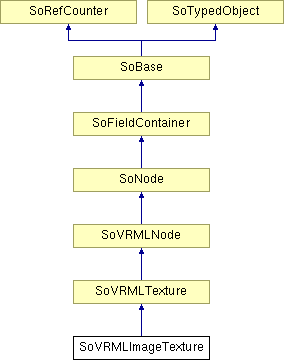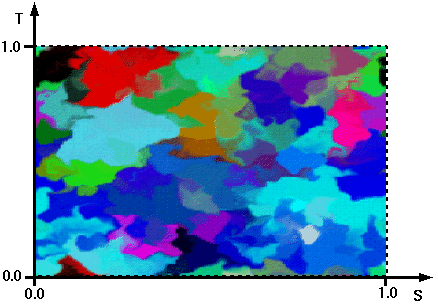SoVRMLImageTexture Class Reference
[VRML97 nodes]
 Texture map node.
More...
Texture map node.
More...
#include <Inventor/VRMLnodes/SoVRMLImageTexture.h>

Public Types | |
| enum | FileType { UNKNOWN = SoTexture::UNKNOWN, RGB = SoTexture::RGB, SGI = SoTexture::SGI, TIFF = SoTexture::TIFF, GIF = SoTexture::GIF, JPEG = SoTexture::JPEG, BMP = SoTexture::BMP, PNG = SoTexture::PNG, JPEG2000 = SoTexture::JPEG2000, PGX = SoTexture::PGX, PNM = SoTexture::PNM, RAS = SoTexture::RAS, DDS = SoTexture::DDS, HDRI = SoTexture::HDRI, NUM_FILETYPES } |
Public Member Functions | |
| virtual SoType | getTypeId () const |
| SoVRMLImageTexture () | |
| void | allowPrequalifyFile (SbBool) |
| void | setBitmapFileType (FileType in_type) |
| FileType | getBitmapFileType (void) |
| const unsigned char * | getImage (SbVec2s &size, int &numcomp) |
Static Public Member Functions | |
| static SoType | getClassTypeId () |
| static void | setPrequalifyFileCallBack (VRMLPrequalifyFileCallback *, void *) |
Public Attributes | |
| SoMFFilePathString | url |
Detailed Description
 Texture map node.
Texture map node.
The SoVRMLImageTexture node defines a texture map by specifying an image file and general parameters for mapping to geometry. Texture maps are defined in a 2D coordinate system, (s,t), that ranges from 0.0 to 1.0 in both directions. The bottom edge of the image corresponds to the S-axis of the texture map, and left edge of the image corresponds to the T-axis of the texture map. The lower-left pixel of the image corresponds to s=0, t=0, and the top-right pixel of the image corresponds to s=1, t=1.
NOTE: This class does not exist in Open Inventor 10.0 and later.Texture images may be one component (grayscale), two component (grayscale plus transparency), three component (full RGB color), or four-component (full RGB color plus transparency).
The repeatS and repeatT fields specify how the texture wraps in the S and T directions. If repeatS is TRUE (the default), the texture map is repeated outside the 0-to-1 texture coordinate range in the S direction so that it fills the shape. If repeatS is FALSE, the texture coordinates are clamped in the S direction to lie within the 0-to-1 range. The repeatT field is analogous to the repeatS field.
If the texture image's width or height is not a power of 2, or the image's width or height is greater than the maximum supported by OpenGL, then the image will be automatically scaled up or down to the next power of 2 or the maximum texture size. For maximum speed, point-sampling is used to do the scale; if you want more accurate resampling, pre-filter images to a power of 2 smaller than the maximum texture size (use the OpenGL glGetIntegerv(GL_MAX_TEXTURE_SIZE...) call to determine maximum texture for a specific OpenGL implementation).
The quality of the texturing is affected by the textureQuality field of the SoComplexity node. The textureQuality field affects what kind of filtering is done to the texture when it must be minified or magnified. The mapping of a particular texture quality value to a particular OpenGL filtering technique is implementation dependent, and varies based on the texturing performance. If mipmap filtering is required, mipmaps are automatically created using the simple box filter.
Open Inventor can read GIF, JPEG, PNG, RGB (native Silicon Graphics format), TIFF, and BMP texture files.
Performance Note: Automatic scaling of texture images to a power of 2 is a very convenient feature for prototyping, but it does take additional time the first time the texture node is traversed for rendering. For large images, or a large number of images, this can make the application seem slow while starting up or loading a new data file. Avoid this effect by either pre-scaling the image or by storing it as a sub-image in a "power of 2" image (then provide explicit texture coordinates such that only the sub-image is used).
VRML97 SPECIFICATION
- This section describes the expected behavior of the node in a conforming VRML97 browser application. In some cases, the application is responsible for implementing portions of the expected behavior. Open Inventor viewer classes and IVF classes implement some of the application behaviors.
This section may reference portions of the VRML97 specification that are not present in this help file. The complete VRML97 spec is available at http://www.web3d.org .
The SoVRMLImageTexture node defines a texture map by specifying an image file and general parameters for mapping to geometry. Texture maps are defined in a 2D coordinate system, (s,t), that ranges from 0.0 to 1.0 in both directions. The bottom edge of the image corresponds to the S-axis of the texture map, and left edge of the image corresponds to the T-axis of the texture map. The lower-left pixel of the image corresponds to s=0, t=0, and the top-right pixel of the image corresponds to s=1, t=1.

The texture is read from the URL specified by the url field. To turn off texturing, set the url field to have no values ([]). Browsers are required to support the JPEG and PNG image file formats, and in addition, may support any other image formats. Support for the GIF format including transparent backgrounds is also recommended. See the section "Concepts - URLS and URNs" for details on the url field.
Texture images may be one component (grayscale), two component (grayscale plus transparency), three component (full RGB color), or four-component (full RGB color plus transparency). An ideal VRML implementation will use the texture image to modify the diffuse color and transparency of an object's material (specified in an SoVRMLMaterial node), then perform any lighting calculations using the rest of the object's material properties with the modified diffuse color to produce the final image. The texture image modifies the diffuse color and transparency depending on how many components are in the image, as follows:
1. Diffuse color is multiplied by the grayscale values in the texture image.
2. Diffuse color is multiplied by the grayscale values in the texture image; material transparency is multiplied by transparency values in texture image.
3. RGB colors in the texture image replace the material's diffuse color.
4. RGB colors in the texture image replace the material's diffuse color; transparency values in the texture image replace the material's transparency.
See "Concepts - Lighting Model" for details on lighting equations and the interaction between textures, materials, and geometries.
Browsers may approximate this ideal behavior to increase performance. One common optimization is to calculate lighting only at each vertex and combining the texture image with the color computed from lighting (performing the texturing after lighting). Another common optimization is to perform no lighting calculations at all when texturing is enabled, displaying only the colors of the texture image.
The repeatS and repeatT fields specify how the texture wraps in the S and T directions. If repeatS is TRUE (the default), the texture map is repeated outside the 0-to-1 texture coordinate range in the S direction so that it fills the shape. If repeatS is FALSE, the texture coordinates are clamped in the S direction to lie within the 0-to-1 range. The repeatT field is analogous to the repeatS field.
FILE FORMAT/DEFAULT
- VRMLImageTexture {
| url | [] |
| repeatS | TRUE |
| repeatT | TRUE |
| metadata | NULL |
ACTION BEHAVIOR
EVENTS
- Deprecated:
-
Deprecated since Open Inventor 9500
The VRML API is no longer supported. See section http://oivdoc95.vsg3d.com/content/compatibility-notes-4#Deprecation of the Reference Manual. - Inventor/VRMLnodes/SoVRMLImageTexture.h
eventIn
| SoMFString | set_url |
| SoSFNode | set_metadata |
eventOut
| SoMFString | url_changed |
| SoSFNode | metadata_changed |
Member Enumeration Documentation
Constructor & Destructor Documentation
| SoVRMLImageTexture::SoVRMLImageTexture | ( | ) |
Constructor.
Member Function Documentation
| void SoVRMLImageTexture::allowPrequalifyFile | ( | SbBool | ) |
Sets the prequalify file flag.
If FALSE, the prequalification callback will not be called. Default is TRUE.
| FileType SoVRMLImageTexture::getBitmapFileType | ( | void | ) | [inline] |
| static SoType SoVRMLImageTexture::getClassTypeId | ( | ) | [static] |
Returns the type identifier for this class.
Reimplemented from SoVRMLTexture.
| const unsigned char* SoVRMLImageTexture::getImage | ( | SbVec2s & | size, | |
| int & | numcomp | |||
| ) |
Query the image.
| virtual SoType SoVRMLImageTexture::getTypeId | ( | ) | const [virtual] |
Returns the type identifier for this specific instance.
Reimplemented from SoVRMLTexture.
| void SoVRMLImageTexture::setBitmapFileType | ( | FileType | in_type | ) | [inline] |
| static void SoVRMLImageTexture::setPrequalifyFileCallBack | ( | VRMLPrequalifyFileCallback * | , | |
| void * | ||||
| ) | [static] |
Specifies the application callback that will be invoked when the ImageTexture node is about to read an image file (if the prequalify flag is TRUE).
Member Data Documentation
Filename (or URL) from which to read the texture image.
Note: Open Inventor only tries to open the first URL in the field.
The documentation for this class was generated from the following file: